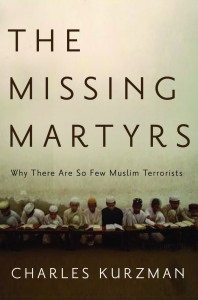
In his new book The Missing Martyrs: Why There Are So Few Muslim Terrorists (Oxford University Press), University of North Carolina sociologist Charles Kurzman portrays Islamic terrorists as often behaving like the “gang that couldn’t shoot straight,” as they miss their targets, fail to create much of a following, and are strongly divided among themselves. Kurzman does not discount the threat of terrorism, but he stresses that it is a rarer phenomenon than should be the case if many media reports and security experts have been on target about the sharp growth of Islamic extremism during the past decade.
Kurzman’s book is unique among the steady stream of books on terrorism and Islam in devoting most of its pages to how Islamic extremists have been most ineffective and unpopular in their attacks both against the West and fellow Muslim societies. He builds his case by conducting and examining survey research, interviewing Muslims (both those sympathetic and against extremism), and studying extremist internal documents and websites.
Kurzman notes that there may well have been tens of thousands of prospective Islamic militants in the last quarter of a century, but most of them received little significant training and have dropped out of the movement. Even if they are still active, more than 99 percent of the world’s billion Muslims have ignored the militants’ constant calls to action. “Global Islamist terrorists have managed to recruit fewer than 1 in 15,000 Muslims over the past quarter century and few than 1 in 100,000 Muslims since 9/11,” he writes. This shortage of qualified terrorists has translated to terrorist attacks that are few and far between-for instance, Kurzman finds that in the five years after 9/11, only 40 Muslim-Americans planned or carried out acts of domestic terrorism.
While terrorist organizations often claim they have waiting lists of volunteers eager to serve as martyrs, Kurzman finds that such lists are shorter than claimed, and most of the applicants were not deemed suitable for terrorist missions in the West. Even youths who admire terrorist leaders and view jihad as “cool,” rarely reported interest in actually joining the ranks of such groups as Al Queda.
The main reason for the dearth of terrorists is that they are facing division and competition on several fronts. The global jihadists, such as Al Queda, compete for followings with nationalist-based Islamic movements, such as the Taliban of Afghanistan or Hamas of Palestine. While the former envisions a worldwide Islamic revolution, the latter groups tend to be more interested in Islamicizing their own societies and fighting foreign intervention. Although there are periods when nationalist-based terrorists work together with global Islamist terrorists, such as in Afghanistan and Iraq during the wars with the U.S., these alliances are usually temporary due to ideological and theological differences, according to Kurzman. For instance, the Taliban’s belief in maintaining Muslim shrines of deceased religious leaders was often a point of contention for a group such as Al Queda, that believed such observance was a heretical diversion from pure Islam.
Global Islamic terrorist movements also compete with more liberal Islamic movements and societies. While liberal Islamic movements and institutions often represent a small elite in many societies, Kurzman cites their influence in the growing democratic sentiments of majorities in Muslim countries. At the same time, many Muslims still support the implementation of Sharia, or Islamic law, in their societies. It is this combination of social conservatism and democratic tendencies that offer the best counterweight to the appeal of terrorists, he adds. What Kurzman calls Islamic “televangelism,” as seen in the strong appeal of Islamic media personalities and teachers such as Amr Khaled of Egypt, also offers “stiff competition for the revolutionaries…Both televangelists and revolutionaries offer parallel messages of Islamic renewal, calling for Muslims to reject their debauched ways and return to a stylized version of pure, early Islam-without giving up the modern ideas such as technological progress, economic development, and human equality.”
Kurzman declines to offer predictions and forecasts on the prospects for future terrorist attacks. In fact, he spends a chapter suggesting that the security experts, think tanks, and even his own academic colleagues in Middle Eastern and Islamic studies have benefited from the public anxiety about terrorism but have not been very accurate in predicting these occurrences. He criticizes government-based efforts such as the Defense Advanced Research Projects Agency (DARPA), and the Minerva Initiative, which enlists academics to use advanced social science computer and statistical methods to predict change and conflict in the Middle East and other Muslim societies and advance new policies.
Kurzman concludes that while terrorism may be exaggerated by governments and security experts, it is not the case that political leaders and specialists can easily defuse animosity and violent incidents. Neither aggressive U.S. foreign policy nor trying to foster diplomacy and pro-Islamic policies seem to prevent terrorism, since “Muslim attitudes toward the United States are largely stuck on negative.” But an emphasis on listening to Islamic countries’ concerns and building stronger relationships with the civilians on the ground during armed conflicts may go some way toward fostering more positive attitudes toward the U.S., he writes.
Richard Cimino
Charles Kurzman , The Missing Martyrs: Why There Are So Few Muslim Terrorists, Oxford University Press, 2011 (256 p.).